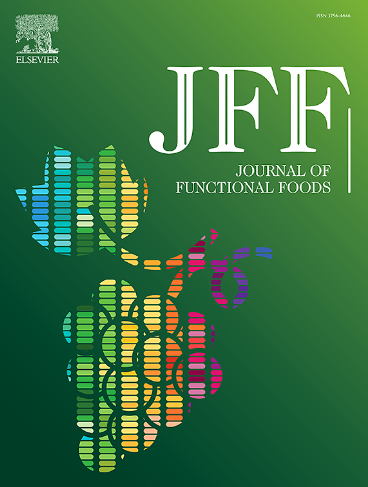Lycopus lucidus Turcz. extract ameliorates CCl4-induced liver damage by MAPK/Nrf2 signaling pathways and gut microbiota in mice
IF 3.8
2区 农林科学
Q2 FOOD SCIENCE & TECHNOLOGY
引用次数: 0
Abstract
This work explored the protection of free phenolic extract from Lycopus lucidus root (FPLR) against liver damage caused by CCl4 and its underlying mechanisms in mice. Mice were separated into the normal group (control), model group (CCl4), and FPLR group (FPLR+ CCl4). FPLR reduced liver or spleen index, improved liver function, and alleviated histopathological lesions, oxidative stress, and inflammation. Meanwhile, FPLR inhibited protein phosphorylation in the mitogen-activated protein kinases (MAPK) pathway, up-regulated gene and protein expression in the Nuclear Factor erythroid 2-Related Factor 2 (Nrf2) pathway, and down-regulated kelch-like ECH-associated protein 1 (Keap1) expression. Furthermore, FPLR increased the number of beneficial gut microbes, including Bacteroidales_S24_7_group, Lactobacillus, and Parabacteroides distasonis, while lowering the Firmicutes/Bacteroidetes ratio and harmful ones, such as Streptococcaceae, Ruminococcaceae_UCG-014, and Oscillibacter (all p < 0.05). Correlation analysis suggested nine bacteria, including Lactobacillus, Staphylococcus, and Parabacteroides_distasonis, played an important role in preventing liver damage, activating the Nrf2 pathway and inhibiting Keap1. In conclusion, FPLR successfully mitigated CCl4-induced liver damage by modulating the MAPK/Nrf2 pathways and gut microbiota.

绿番茄。提取物可通过MAPK/Nrf2信号通路和肠道菌群改善ccl4诱导的小鼠肝损伤
本研究探讨了Lycopus lucidus根游离酚提取物(FPLR)对CCl4致小鼠肝损伤的保护作用及其机制。将小鼠分为正常组(对照组)、模型组(CCl4)和FPLR组(FPLR+ CCl4)。FPLR可降低肝脏或脾脏指数,改善肝功能,减轻组织病理病变、氧化应激和炎症。同时,FPLR抑制丝裂原活化蛋白激酶(MAPK)通路蛋白磷酸化,上调核因子红系2相关因子2 (Nrf2)通路基因和蛋白表达,下调kelch样ech相关蛋白1 (Keap1)表达。此外,FPLR增加了有益肠道微生物的数量,包括拟杆菌(Bacteroidales_S24_7_group)、乳酸杆菌(Lactobacillus)和副拟杆菌(parabobacterides distasonis),降低了厚壁菌门/拟杆菌门(Bacteroidetes)和有害肠道微生物的比例,如链球菌科(Streptococcaceae)、瘤胃球菌(Ruminococcaceae_UCG-014)和Oscillibacter(均p <;0.05)。相关分析表明,乳杆菌、葡萄球菌、类副芽孢杆菌等9种细菌在预防肝损伤、激活Nrf2通路和抑制Keap1中发挥重要作用。综上所述,FPLR通过调节MAPK/Nrf2通路和肠道微生物群,成功减轻了ccl4诱导的肝损伤。
本文章由计算机程序翻译,如有差异,请以英文原文为准。
求助全文
约1分钟内获得全文
求助全文
来源期刊

Journal of Functional Foods
FOOD SCIENCE & TECHNOLOGY-
CiteScore
9.60
自引率
1.80%
发文量
428
审稿时长
76 days
期刊介绍:
Journal of Functional Foods continues with the same aims and scope, editorial team, submission system and rigorous peer review. We give authors the possibility to publish their top-quality papers in a well-established leading journal in the food and nutrition fields. The Journal will keep its rigorous criteria to screen high impact research addressing relevant scientific topics and performed by sound methodologies.
The Journal of Functional Foods aims to bring together the results of fundamental and applied research into healthy foods and biologically active food ingredients.
The Journal is centered in the specific area at the boundaries among food technology, nutrition and health welcoming papers having a good interdisciplinary approach. The Journal will cover the fields of plant bioactives; dietary fibre, probiotics; functional lipids; bioactive peptides; vitamins, minerals and botanicals and other dietary supplements. Nutritional and technological aspects related to the development of functional foods and beverages are of core interest to the journal. Experimental works dealing with food digestion, bioavailability of food bioactives and on the mechanisms by which foods and their components are able to modulate physiological parameters connected with disease prevention are of particular interest as well as those dealing with personalized nutrition and nutritional needs in pathological subjects.
 求助内容:
求助内容: 应助结果提醒方式:
应助结果提醒方式:


